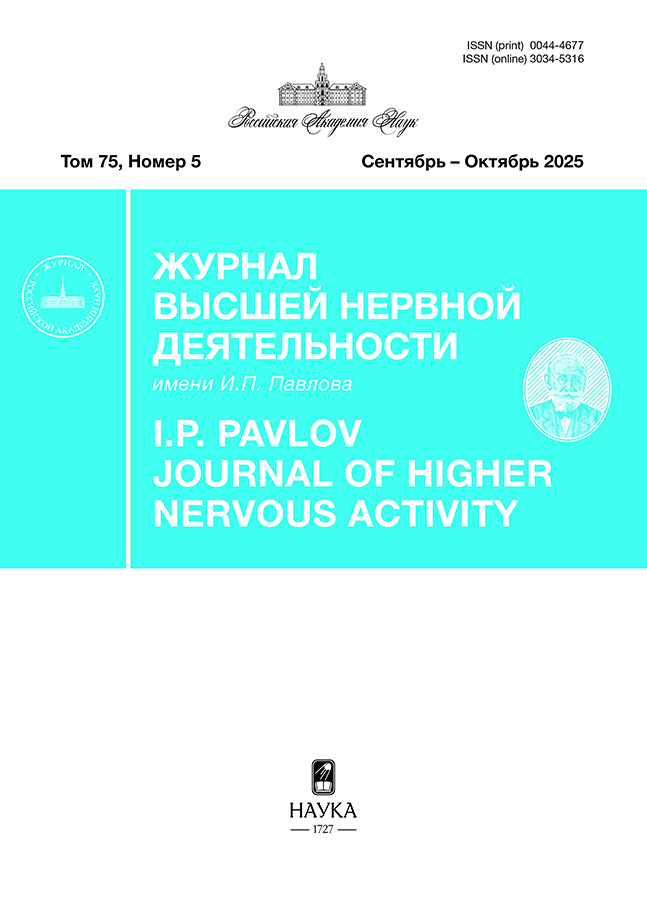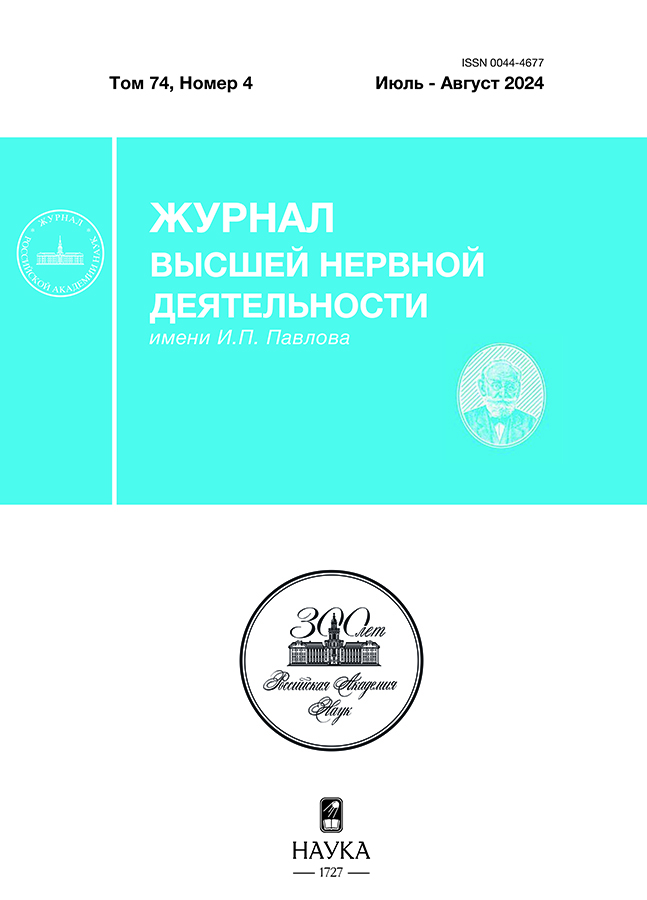Зависимость амплитудных и фазовых характеристик вазомоторных колебаний от условий зрительной стимуляции и длительности проведения эксперимента
- Авторы: Кожухов С.А.1, Салтыков К.А.2, Бондарь И.В.2
-
Учреждения:
- Институт высшей нервной деятельности и нейрофизиологии РАН
- Институт высшей нервной деятельности и нейрофизиологии Российской академии наук
- Выпуск: Том 74, № 4 (2024)
- Страницы: 496-514
- Раздел: МЕТОДИКА
- URL: https://kld-journal.fedlab.ru/0044-4677/article/view/652085
- DOI: https://doi.org/10.31857/S0044467724040108
- ID: 652085
Цитировать
Полный текст
Аннотация
Метод оптического картирования по внутреннему сигналу широко используется в экспериментальных, теоретических и прикладных исследованиях функциональной анатомии коры головного мозга млекопитающих. Однако регистрируемый сигнал, коррелирующий с нейронной активностью, маскируется фоновой активностью, которая может на порядок превышать величину картирующего сигнала. Большая часть фоновой активности состоит из спонтанных колебаний частотой от 0.01 до 0.15 Гц, называемых вазомоторными колебаниями. В данной работе мы показали, что эти колебания меняются в течение времени проведения эксперимента. Большему воздействию подвержены колебания в частотном диапазоне от 0.05 до 0.15 Гц. При этом мощность вазомоторных колебаний уменьшается более существенно, чем показатель стабильности их фазовых характеристик. В работе обсуждаются методические подходы по минимизации влияния вазомоторных колебаний на построенные методом оптического картирования функциональные карты.
Полный текст
Об авторах
С. А. Кожухов
Институт высшей нервной деятельности и нейрофизиологии РАН
Автор, ответственный за переписку.
Email: sergei.kozhukhov@ihna.ru
Россия, Москва
К. А. Салтыков
Институт высшей нервной деятельности и нейрофизиологии Российской академии наук
Email: sergei.kozhukhov@ihna.ru
Россия, Москва
И. В. Бондарь
Институт высшей нервной деятельности и нейрофизиологии Российской академии наук
Email: sergei.kozhukhov@ihna.ru
Россия, Москва
Список литературы
- Арнольд В.И. Теория катастроф. М.: Едиториал УРСС. 2008.
- Бугрова В.С., Бондарь И.В. Устойчивость функциональных доменов ориентационной и дирекциональной чувствительности первичной зрительной коры кошки к воздействию пропофола. Журн. высш. нервн. деят. им. И.П. Павлова. 2019. 69 (2): 218–229.
- Кожухов С.А., Салтыков К.А., Бондарь И.В. Оптическое картирование зрительной коры: спектральные и амплитудные характеристики вазомоторных колебаний. Журн. высш. нервн. деят. им. И.П. Павлова. 2022. 72 (6): 880–895.
- Латанов А.В., Панкова Н.Б. Использование метода БОС-коррекции для оптимизации функционального состояния организма человека при высокогорном восхождении. Экология человека. 2018. 25 (4): 22–29.
- Bibolett-Bahena O., Tissier S., Ho-Tran S., Rojewski A., Casanova C. Enriched environment exposure during deve lopment positively impacts the structure and function of the visual cortex in mice. Sci. Rep. 2023. 13(1): 7020.
- Bian N., Yuan Y., Li Y., Liu M., Li X. Low-intensity pulsed ultrasound stimulation inhibits cortical spreading depression. Cereb. Cortex. 2021. 531 (8): 3872–3880.
- Bice A.R., Xiao Q., Kong J., Yan P., Rosenthal Z.P., Kraft A.W., Smith K.P., Wieloch T., Lee J.M., Culver J.P., Bauer A.Q. Homotopic contralesional excitation suppresses spontaneous circuit repair and global network reconnections following ischemic stroke. Elife. 2022. 11: e68852.
- Bonhoeffer T., Grinvald A. Iso-orientation domains in cat visual cortex are arranged in pinwheel-like patterns. Nature. 1991. 353 (6343): 429–431.
- Cai X., Xu H., Han C., Li P., Wang J., Zhang R., Tang R., Fang C., Yan K., Song Q., Liang C., Lu H.D. Mesoscale functional connectivity in macaque visual areas. Neuroimage. 2023. 271: 120019.
- Chung D.Y., Oka F., Jin G., Harriott A., Kura S., Aykan S.A., Qin T., Williams J.E., Lee H., Yaseen M.A., Sakadzic S., Boas D.A., Whalen M.J., Ayata C. Subarachnoid hemorrhage leads to early and persistent functional connectivity and behavioral changes in mice. J. Cereb. Blood Flow Metab. 2021. 41 (5): 975–985.
- Du X., Jiang X., Kuriki I., Takahata T., Zhou T., Roe A.W., Tanigawa H. Representation of cone-opponent color space in macaque early visual cortices. Front. Neurosci. 2022. 16: 891247.
- Fang C., Cai X., Lu H. Orientation anisotropies in macaque visual areas. Proc. Natl. Acad. Sci. USA. 2022. 119 (15): e2113407119.
- Friedman R.M., Gehade N.G., Roe A.W., Gharbawie O.A. Optical imaging reveals functional domains in primate sensorimotor cortex. Neuroimage. 2020. 221: 117188.
- Fukunaga M., Horovitz S.G., van Gelderen P., Zwart J.A., Jansuma J.M., Ikonomidou V.N., Chu R., Deckers R.H.R., Leopold D.A., Duyn J.H. Large-amplitude, spatially correlated fluctuations in BOLD fMRI signals during extended rest and early sleep stages. Magn. Reson. Imaging. 2006. 24 (8): 979–992.
- Griffith T.M., Edwards D.H. Fractal analysis of role of smooth muscle Ca2+ fluxes in genesis of chaotic arterial pressure oscillations. Am. J. Physiol. 1994. 266 (5 Pt 2): H1801–H1811.
- Julien C., Zhang Z.Q., Cerutti C., Barres C. Hemodynamic analysis of arterial pressure oscillations in conscious rats, J. Auton, Nerv. Syst. 1995. 50 (3): 239–252.
- Hald B.O., Sorensen R.B., Sorensen P.G., Sorensen C.M., Jacobsen J.C.B. Stimulation history affects vasomotor responses in rat mesenteric arterioles. Pflugers Arch. 2019. 471 (2): 271–283.
- Holm S. A simple sequentially rejective multiple test procedure. Scand. J. Statistics. 1979. 6(2): 65–70.
- Kalatsky V.A., Stryker M.P. New paradigm map for optical imaging: temporally encoded maps of intrinsic signals. Neuron. 2003. 38 (4): 529–545.
- Kozhukhov S.A., Ivanov R.S., Bugrova V.S., Verkhlyutov V.M., Ushakov V.L. Functional asymmetry of local connections in V1 and its impact on orientation tuning. Proc. Comp. Sci. 2020. 169: 620–639.
- Lai J.H., Qin T., Sakadzic S., Ayata C., Chung D. Cortical spreading depolarizations in a mouse model of subarachnoid hemorrhage. Neurocrit. Care. 2022. 37: 123–132.
- Li M., Chen X., Yuan N., Lu Y., Liu Y., Gong H., Qian L., Andolina I.M., Wu J., Zhang S., McLoughlin N., Sun X., Wang W. Effects of acute high intraocular pressure on red-green and blue-yellow cortical color responses in non-human primates. Neuroimage Clin. 2022. 35: 103092.
- Lu H.D., Chen G., Cai J., Roe A.W. Intrinsic signal optical imaging of visual brain activity: tracking of fast cortical dynamics. Neuroimage. 2017. 148: 160–168.
- Machado C., Estevez M., Perez-Nellar J., Schiavi A. Residual vasomotor activity assessed by heart rate variabi lity in a brain-dead case. BMJ Case Rep. 2015. 2015: bcr2014205677.
- Mayhew J.E., Zheng A.Y., Westby G.W., Redgrave P., Rector D.M., Harper R.M. Cerebral vasomotion: a 0.1-Hz oscillation in reflected light imaging of neural activity. Neuroimage. 1996. 4 (3 Pt 1): 183–193.
- Nsigani A., Rosario J.D., Yeh A.C., Shin D., Wells S., Lev-Ari T., Williams B., Haider B. Optimizing intact skull intrinsic signal imaging for subsequent targeted electrophysiology across mouse visual cortex. Sci. Rep. 2022. 12 (1): 2063.
- Olschfagel M., Polanski W.H., Morgenstern U., Steiner G., Kirsch M., Koch E., Schackert G., Sobbotka S. Characterization of cortical hemodynamic changes following sensory, visual and speech activation by intraoperative optical imaging utilizing phase-based evaluation methods. Hum. Brain Mapp. 2022. 43 (2): 598–615.
- Partimos D., Haddock R.E., Hill C.E., Griffith T.M. Dyna mics of three-variable nonlinear model of vasomotion: comparison of theory and experiment. Biophys. J. 2007. 93 (5): 1534–1556.
- Pradhan R.K., Chakravarthy V.S. Information dynamics of vasomotion in microvascular networks: a review. Acta Physiol (Oxf). 2011. 201 (2): 193–218.
- Peng H., Matchkov V.A., Aalkjaer C., Nilsson H. Hypo thesis for the initiation of vasomotion. Circ. Res. 2001. 88 (8): 810–815.
- Takato R., Korhonen I., Majahalme S., Tuomisto M., Turjanmaa V. Circadian profile of low-frequency oscillations in blood pressure and heart rate in hypertension. Am. J. Hypertens. 1999. 12 (9 Pt. 1): 874–881.
- Roe A.W. Long-term optical imaging of intrinsic signals in anesthetized and awake monkeys. Appl. Opt. 2007. 46 (10): 1872–1880.
- Schumikhina S.I., Bondar I.V., Svinov M.M. Dynamics of stability of orientation maps recorded with optical imaging. J. Neuroscience. 2018. 374: 49–60.
- Silvani A., Bojic T., Franzini C., Lenzi P., Walker A.M., Grantr D.A., Wild J., Zoccoli G. Sleep-related changes in the regulation of cerebral blood flow in newborn lambs. Sleep. 2004. 27 (1): 36–41.
- Sintsov M., Suchkov D., Khazipov R., Minlebaev M. Developmental changes in sensory-evoked optical intrinsic signals in the rat barrel cortex. Front. Cell Neurosci. 2017. 11: 392.
- Shumkova V., Sitdikova V., Rechapov I., Leukhin A., Minlebaev M. Effects of urethane and isoflurane on the sensory evoked response and local blood flow in the early postnatal rat somatosensory cortex. Sci. Rep. 2021. 11(1): 9567.
- Shumikhina S.I., Bondar I.V., Svinov M.M. Dynamics of stability of orientation maps recorded with optical imaging. Neuroscience. 2018. 374: 49–60.
- Takashima I., Kajiwara R. Voltage-sensitive dyes versus intrinsic signal optical imaging: comparison of tactile responses in primary and secondary somatosensory cortices of rats. Brain Sci. 2021. 11 (10): 1294.
- Tanaka S., Miyashita M., Wakabayashi N., O’Hashi N., Tani T., Ribot J. Development and reorganization of orientation representation in the cat visual cortex: experience-dependent synaptic rewiring in early life. Front. Neuroinform. 2020. 14: 41.
- Tang R., Song Q., Li Y., Zhang R., Cai X., Lu H.D. Curvature-processing domains in primate V4. Elife. 2020. 9: e57502.
- Tao J., Wang D., Jin A., Xue J., Yu H. Response of somatosensory cortex following thermal stimuli to dental implants. Neurosci. Lett. 2022. 784: 136750.
- Tong Y., Hocke L.M., Frederick B.B. Low frequency syste mic hemodynamic “noise” in resting state BOLD fMRI: characteristics, causes, implications, mitigation strategies and applications. Front. Neurosci. 2019. 13: 787.
- Townsend L.B., Jones K.A., Dorsett C.R., Philpot B.D., Smith S.L. Deficits in higher visual area representations in a mouse model of Angelman syndrome. J. Neurodev. Disord. 2020. 12 (1): 28.
- Vermeij A., Meel-van den Abeelen A.S.S., Kessels R.P.C., van Beek A.H.E.A., Claassen J.A.H.R. Very-low-frequency oscillations of cerebral hemodynamics and blood pressure are affected by aging and cognitive load. Neuroimage. 2014. 85 Pt 1: 608–615.
- Wang D., Tao J., Jin A., Yu H. Tactile sensation of natural teeth and dental implants in the somatosensory cortex. J. Prosthodont. Res. 2022. 66 (2): 272–278.
- Xue J., Wang D., Jin A., Tao J., Yu H. Invesigating the role of gingiva in the tactile function of teeth at the cortical level. Neurosci. Lett. 2021. 764: 136198.
- Zhang Y., Schriver K.E., Hu J.M., Roe A.W. Spatial frequency representation in V2 and V4 of macaque monkey. Elife. 2023. 12: e81794.
Дополнительные файлы
















